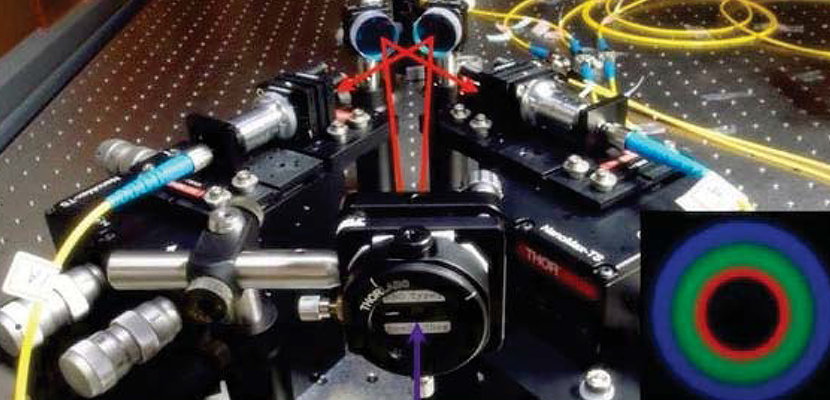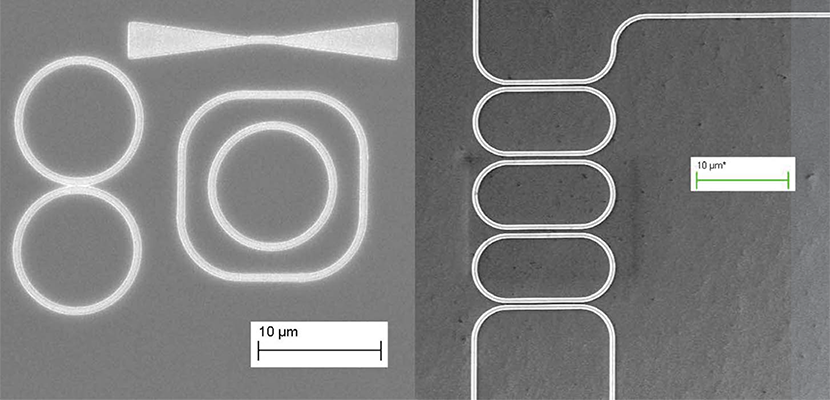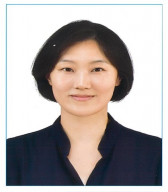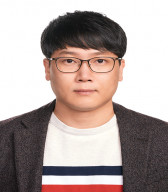Using SUPERPOSITION and ENTANGLEMENT of quantum mechanics, we can describe it as a quantum superposition state (QUBIT Superposition of 0,1) instead of 0 or 1 which is the basic unit of classical information. By the this technique we can proceed quantum simulations, quantum computation and quantum cryptography it is possible to enable computational and communication protocols that are not classically possible, our QUANTUM OPTICS & QUANTUM INFORMATION laboratory we research quantum entanglement, quantum imaging and quantum information are being studied using single photons.
Nanostructure-light interaction make quantum and nonlinear physical phenomenon that has not been seen before. In the QUANTUM NANO-PHOTONICS laboratory, we design and fabricate ultra-small nano-optical devices by the nano fabrication processes to generate quantum photon pairs. By the using Quantum optical integrated circuits we research quantum cryptography communication. In addition, QUANTUM NANO-PHOTONICS laboratory research various nonlinear phenomena (Brillouin scattering, Raman scattering, OPTOMECHANICS, etc.) occurring in nano-optical devices are under study.
ULTRACOLD QUANTUM GASES (Park, Jee Woo)
Quantum systems with robust coherence hold the promise to realize quantum simulators and quantum computing platforms that go beyond the bounds of classical technology. Our research group focuses on the use of ultracold atoms and molecules prepared at nano-Kelvin temperatures to construct a highly coherent and programmable many-particle system that not only allows to tackle challenging problems in quantum many-body physics, but also allows to build a scalable quantum processor that significantly extends the number of qubits available for computation.
Ultrafast Phenomena and Control in Solids(Kim Heejae)
Materials’ functional properties are determined by the interplay among various degrees of freedom (electrons, spin, crystal lattice), in general. We study these interactions in an element-resolved fashion using femtosecond time-resolved techniques (from Terahertz to X-ray spectral range). Further, we aim at discovering new material phases and functions by manipulating a specific degree of freedom with strong field ultrafast optical pulses in quantum materials.
SUPER-RESOLUTION IMAGING & SPECTROSCOPY(Kyoung-Duck Park)
The primary goal of our lab is to develop ultrafast super-resolution microscopy and spectroscopy with spatial and temporal resolutions of <10 nm and <100 fs, respectively, surpassing the diffraction limit of light. This advancement will enable the observation of previously unobservable physical phenomena in both the time and space domains. In terms of instrumentation, our focus is on pioneering novel near-field imaging and spectroscopy techniques that redefine the current paradigm of near-field microscopy. Regarding the characterization of condensed matter, our research is centered on uncovering the newly emergent physical properties in nanoscale regions of low-dimensional quantum materials, including the ultrafast dynamics of various quasiparticles. Furthermore, we not only explore the quantum optical properties of novel quasiparticles dynamically control them in the strong coupling regime through tip-enhanced cavity-spectroscopy.











_168x192.jpg)
-2.gif)









 Login
Login


